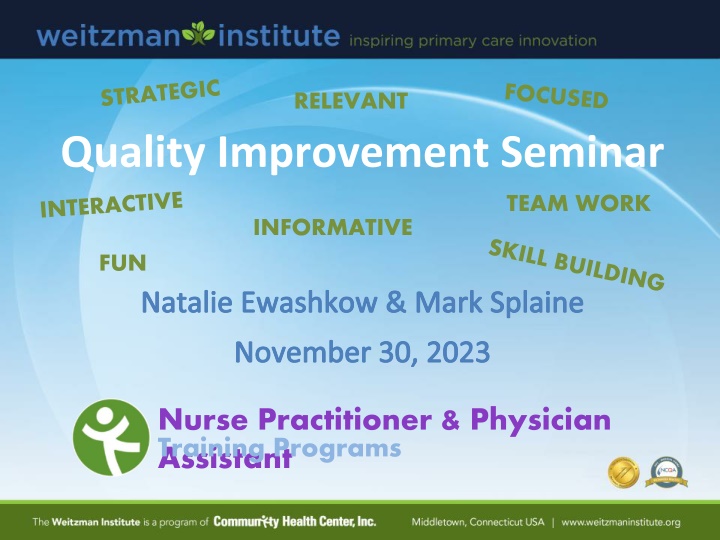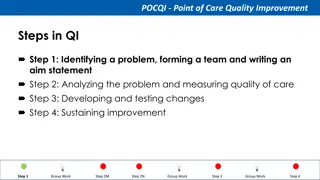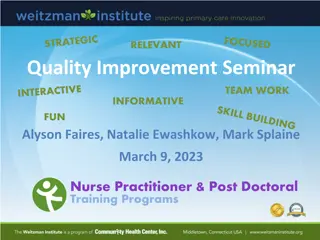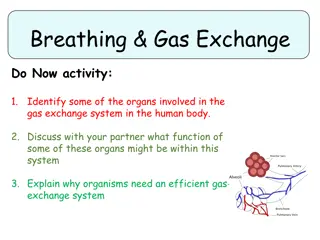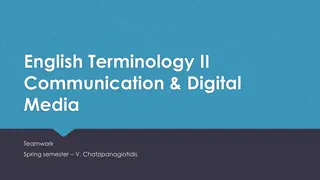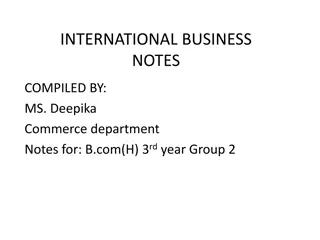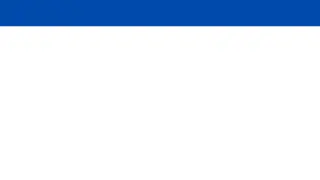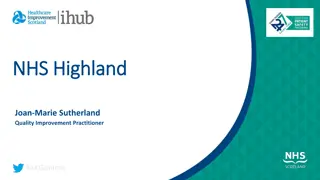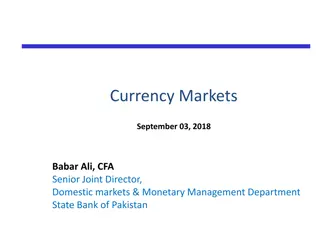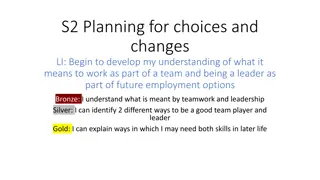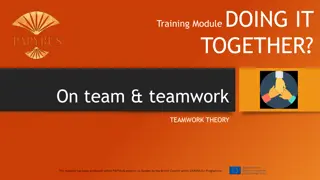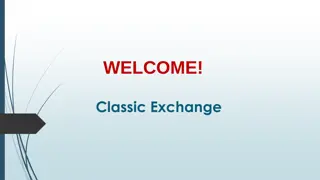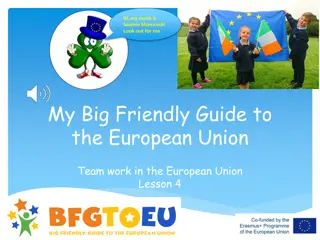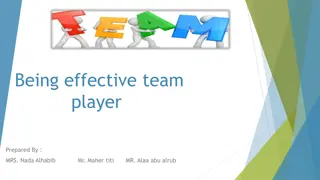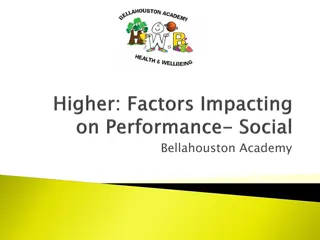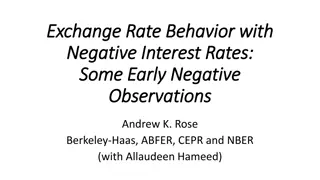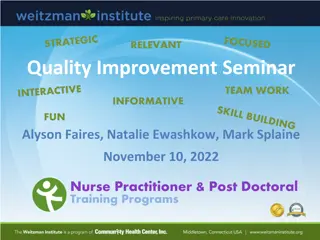Quality Improvement Seminar: Teamwork & Information Exchange
This seminar, led by Natalie Ewashkow and Mark Splaine, focuses on drafting global aim statements, problem statements, and using fishbone diagrams for quality improvement projects. The agenda includes theory bursts, group discussions, and practical exercises to enhance skills in quality improvement. The curriculum plan outlines sessions on stakeholder considerations, process mapping, measurement strategies, communication, negotiation, and sustaining improvement efforts. Participants will engage with tips for developing effective global aim statements to drive impactful changes in healthcare practices.
Download Presentation

Please find below an Image/Link to download the presentation.
The content on the website is provided AS IS for your information and personal use only. It may not be sold, licensed, or shared on other websites without obtaining consent from the author.If you encounter any issues during the download, it is possible that the publisher has removed the file from their server.
You are allowed to download the files provided on this website for personal or commercial use, subject to the condition that they are used lawfully. All files are the property of their respective owners.
The content on the website is provided AS IS for your information and personal use only. It may not be sold, licensed, or shared on other websites without obtaining consent from the author.
E N D
Presentation Transcript
RELEVANT Quality Improvement Seminar TEAM WORK INFORMATIVE FUN Natalie Ewashkow & Mark Splaine November 30, 2023 Nurse Practitioner & Physician Assistant Training Programs
Session Goals Hear about and discuss your efforts to draft a global aim statement from your project idea Draft a problem statement related to a global aim example Brainstorm ideas to begin populating a fishbone diagram 2
Roles Theory burst presenter Mark Interactive discussion leader, timekeeper & facilitator Natalie Technical genius Sarah Take-home thoughts report-out Nicole 3
Agenda Welcome (10 minutes) Theory burst (5 minutes) Global aim tips Global aim examples (25 minutes) Break Theory burst (5 minutes) Fishbone diagrams Fishbone small group work & discussion (30 minutes) Summary and take-home points (5 mins) Preview of next session (5 minutes) 4
Curriculum Plan An overview of Quality Improvement (10/12/23) Care Observations & Stakeholder Considerations (10/26/23) Organizing your Improvement Project (11/9/23) Global Aim and Fishbone Diagram (11/30/23) Process Mapping (Flowcharts) (12/14/23) Measurement to Inform Change (1/11/24 & 1/25/24) An Approach to Testing a Change (2/8/24) Communication about your Improvement Effort (2/22/24) Stakeholder Analysis & Conflict Management (3/14/24) Managing Up and Gaining Leadership Buy-In (3/28/24) Negotiation (4/11/24) Negotiation and More About Cycles of Change (4/25/24) Sustaining your Improvement Effort (5/9/24) Resident Presentations (5/23/24, 6/13/24, 6/27/24)
Global Aim Statements (Tips) Some things to consider (from NICHQ): The concrete goals you want to achieve Who will benefit from this improvement? Whose interests are served? What will be done? Is it supported by evidence or experience? Where will the change occur? When will it start and stop? What are the boundaries of the processes? What is in, what is out? 6 https://www.nichq.org/insight/qi-tips-formula-developing-great-aim-statement
Global Aim Assignment Decide on the topic for the project you would like to develop at your site (agree together as a group on this) Session preparation: Review templates Watch the two videos on brainstorming Work with your site colleagues to generate a draft of a global aim statement for your project topic If you have time, draft a problem statement and begin filling in your fishbone diagram 7
Reports on Assignment We will hear from three teams: 1 2 3 Share your global aim draft as well as anything your group learned when considering project ideas
Break! Take five minutes to recharge and refresh. 10
Poll Questions Check-in on global aim Experience with fishbone diagrams Thanks for sharing your information!
Fishbone Diagram or Cause & Effect Diagram A tool to help a team work together using a structured approach to brainstorming a list of causes of a problem The head of the fish is the problem: Late for work The bones are causes grouped by category.
Steps to Follow 1. Team must agree on the problem statement related to the global aim first 2. Decide on which general categories you will use. Typical ones include: Equipment/supplies Technology Staff Processes/procedure Environment Patients 3. Begin brainstorming contributing causes (within a category or as a whole) 4. Focus on current state!! No solutions yet! 5. Don t worry about messiness
Work on a Fishbone We will break into project groups (15 minutes) Select a problem statement from one of the teams in your group Brainstorm contributing causes and place the ideas in the template Nominate someone from your group to share how your work went with the large group 16
Small Groups for Fishbone Discussion We will break into project groups: CHC Meriden CHC Meriden/New Britain DePaul CHC Hartford HealthLinc Holyoke HC CHC Middletown/New Britain A & B Yakima CHC Stamford Open Door
Highlights from Project Groups Reporter s summary from some groups -- share 1 or 2 highlights from the discussion
What havent we figured out yet? Questions or issues that remain unclear? 19
Take-home Thoughts Nicole share 1 or 2 ideas you will take away from our discussion 20
Summary You have learned about a framework to guide your thinking about how to organize improvement work Also, we have reviewed some important tools for quality improvement work global aim and fishbone diagram Based on your submissions, it is clear you are already formulating some very good ideas for your projects. Our next step will be to better understand the process related to your project topic. 21
Upcoming Office Hours & Teams The next four office hours will be on 12/7 and 1/4 all from 12:30- 1:30pm EST We would like to meet with each project team once during December or January. Please let us know when your team would like to do this using this link: https://doodle.com/meeting/participate/id/dLYZEJWe Email us if none of the times work for your team and you would like to meet at another time. This discussion will be for us to learn a bit more about your project plan and to think together how we can assist you in your work 22
Session V Highlights We will discuss tips and strategies for using flowcharts to enhance your understanding of an improvement effort We will break into small groups to discuss draft examples of flowchart related to your projects 23
Assignment for Session V Revise your global aim statement, if needed, based on today s discussion or additional ideas you have about your project Next, review your initial fishbone diagram draft, and brainstorm as a group about additional factors that contribute to your problem statement Session preparation (background on flowcharting): Watch the two videos on flowcharting Read the document on flowcharting Work with your site colleagues to generate a draft of the actual process for your project topic If you have time, review your ideas about the process with others involved in the process for their feedback Contact Natalie or Mark if you have questions or need assistance Send a summary of your draft process by Tuesday (12/13/23) Our next session will be on Thursday, 12/14/23 24
Resources to Review The two video links provided below will give you a brief but helpful introduction to developing a process map (flowchart) https://www.youtube.com/watch?v=GoEP4dTAmA Q (simple overview, roughly 4 minutes) https://www.youtube.com/watch?v=JENOhSXzi2U (more detailed info, roughly 8 minutes) We will send you an additional reading to provide more detailed insights about flowcharting 25
References Science of Improvement: Setting Aims. Institute for Healthcare Improvement Website. (http://www.ihi.org/resources/Pages/HowtoImprove/ScienceofI mprovementSettingAims.aspx) Global Aim Statement Document. Society of Teachers of Family Medicine Resource Library Website. (https://resourcelibrary.stfm.org/HigherLogic/System/Downloa dDocumentFile.ashx?DocumentFileKey=27fc6113-ab04-4100- 966c-8d2349b4494c&forceDialog=1) QI Tips: A Formula for Developing a Great Aim Statement. National Institute for Children s Health Quality Website. (https://www.nichq.org/insight/qi-tips-formula-developing- great-aim-statement) American Society for Quality Website. (https://asq.org/quality- resources/fishbone) 26
